"Having adopted three-dimensional (3D) CAD early, we create simulation with CG based on 3D CAD data when proposing design of various structures including bridges instead of using a conventional model,. We show simulation in motion with stereoscopic vision. We have been practicing such an approach for more than 10 years," says Mr. Yasushi Itou, Vice Director of Bridge Design Section, Structure Dept., Transport Infrastructure Division, PACIFIC CONSULTANTS CO., LTD. (PCKK). He also says that when it comes to a system to calculate earth volume based on linear data, they adopted such a system more than 20 years ago.
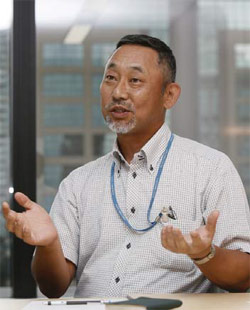 |
| Mr. Yasushi Itou, Vice Director of Bridge Design Section, Structure Dept., Transport Infrastructure Division. |
They are, in a sense, elemental technologies that also lead to CIM (Construction Information Modeling), which has been attracting attention in recent years. Mr. Itou and others have accumulated opportunities for them to get familiar with utilizing advanced ICT (information and communications technology), using the above technologies for years as peripheral technologies necessary for their own business.
Our user to introduce in this issue is Pacific Consultants Co., Ltd., one of the leading construction consulting companies in Japan. We focus on this Structure Dept., Transport Infrastructure Division and Transportation Planning Dept., Management Division, which has accumulated expertise of traffic simulation through projects of various transport systems.
Structure Dept. of Transport Infrastructure Division deals with design and maintenance of road structures including bridges. The Dept. has been a user of FORUM8 products for a long time. The fields of the adopted products range widely from design and analysis to simulation. On the other hand, Transportation Planning Dept., Management Division has been dealing with traffic simulation for more than 10 years, and has developed evacuation simulation by applying traffic simulation in recent years. In that development work, in order to advance the 3D motion of tsunami evacuation simulation created by superimposing the result of other tsunami simulation performed separately, the Dept. adopted UC-win/Road, a 3D real-time VR product of FORUM8 two years ago.
| Leading the Industry in Wide-ranging Fields After the 60th Anniversary of Foundation |
PACIFIC CONSULTANTS CO., LTD. (PCKK) was founded in 1951 as Pacific Consultants Inc. and was registered in the United States (it was reorganized into the present corporation in 1954). In spending more than 60 years since its foundation, PCKK has built up achievements to lead the construction consultant industry in Japan through a wide range of projects such as development and maintenance of infrastructure, disaster prevention and architecture.
Its consulting business can be divided roughly into Project Management, Transport Infrastructure, Land Conservation, New Market Development, and International business. About 1,500 employees support its activity, positioned at the head office (Tama city, Tokyo), metropolitan area head office (Shinjuku Ward, Tokyo), Osaka head office, Branches of Hokkaido, Tohoku, Hokuriku, Chubu, Chugoku, Shikoku, Kyushu, Okinawa; a total of 38 offices within the areas covered by head offices and branches, and Tsukuba Technology and Research Center.
In 2000, the Pacific Consultants International Group (PCIG) was established. PCKK presently composes a corporate group with other 5 subsidiary companies of PCIG, 2 affiliated companies, and 9 subsidiary companies of PCKK.
| Forming an Original Strength Based on ICT |
What characterize PCKK include development of special technologies based on its superiority in ICT, construction of original systems, and accumulated uses of elemental technologies that lead to CIM, such as 3D CAD and simulation as mentioned at the opening.
One of the technological outcomes developed recently is a travelling tunnel inspection system "MIMM." This is a system to perform inspection with a vehicle carrying a high precision laser, CCD cameras, and LED lighting while travelling within a tunnel to solve problems in the present tunnel inspection, such as variation of assessment or oversight depending on the inspector, difficulty in judging progressive deformation, and inefficiency. Not requiring traffic control, it allows the user to grasp present situation and deformation rapidly, objectively and with high precision. Giving positional information to deformation to construct database, effective data for maintenance can also be provided.
Information Systems Dept. that belongs to Management Division combines elemental technologies accumulated in individual fields inside the company not only to create superiority as a general consultant but also to support IT solutions outside. Mr. Keitaro Konuma, Senior Manager in the Composite Technologies Section, Structure Dept., Transport Infrastructure Division focuses on the increase in the needs for a database system to make maintenance of infrastructure more efficient and its simulation as the recent tendency.
They are based on the active efforts of PCKK on utilizing ICT from early and the expertise acquired as a result. Mr. Yasushi Itou summarizes the use of ICT into two phases: before structure is complete (design and simulation) and after completion (work progress control). As to the former, he explains that ICT promotes improvement of efficiency in the design process that is getting sophisticated and complicated. This is backed by the importance of simulation due to the characteristics of the job as construction of a structure, which does not allow experiment or rebuilding with a mock-up, as well as its corporate culture to put emphasis on ICT, and rapid enhancement of environment for using ICT. As to the latter, accumulation of history data by introducing ICT in work progress control will lead to proper judgment of progressive deformation in repair and reinforcement in the future.
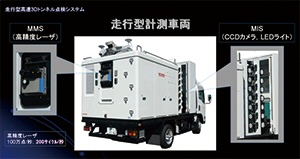 |
| A travelling measuring vehicle (from "Proposal of growth strategy with a travelling tunnel inspection vehicle" released by the PCKK official channel of YouTube "PacificConsultantsJP" ) |
| Structure Dept.: Setting FORUM8 Products as the Basis |
Transport Infrastructure Division we interviewed is mainly engaged with development of transport infrastructure in the fields of roads, railways, airports and more. It covers comprehensive services such as project evaluation, development plan, planning design, structural design, construction supervision and maintenance. Among them, it is road structures including bridges that Structure Dept. deals with.
As the proposal-based order type was increasing in proportion, PCKK paid attention to simulation as an added value. That led to introduction of UC-win/Road in 2006, as Mr. Katsuyuki Ooya, Deputy Manager of Bridge Maintenance Section recalls. Apart from this, having frequent communications as a general contractor with multiple cooperative companies, PCKK originally held many kinds of software products. Later, they basically came to assemble FORUM8 products due to necessity of unifying diversified software. In the next place, putting all the licenses of FORUM8 products together on WAN, a system is under planning to allow their offices all over the nation to access them.
Among them, Mr. Yasushi Itou designs bridges, which acquire emphasis on visual design in particular, in Bridge Design Section. Under such situation, the section introduced 3D CAD early. In addition, a proposal approach using simulation with CG has been applied frequently for more than 10 years.
Mr. Katsuyuki Ooya, who's main job is detailed design of new bridges in Bridge Maintenance Section, says that it is recent tendency to resolve design while making dynamic analysis over a complicated structure. He also tries to deliver the work result with a completed image in a form easy to understand using travel simulation.
On the other hand, Mr. Yohei Higashi, Deputy Manager of the First Bridge Section, Structure Dept. who works on inspection and investigation of existing bridges, and repair and reinforcement design of bridges, says that he mainly uses FORUM8 software for such cases that need detailed explanation as to the member like seismic reinforcement design, though his major work is field works with little emphasis on design and calculation. Recently, application of 3D data to such processes is increasing, says Mr. Higashi.
Just Established last year in the Dept., Composite Technologies Section is further aiming at developing new projects in cooperation with other sections on the basis of bridge design technology. Mr. Keitarou Konuma states that linkage with the software technologies of FORUM8 is widely examined there.
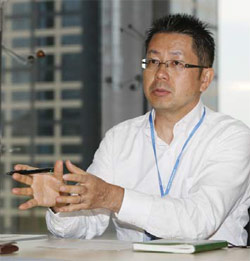 |
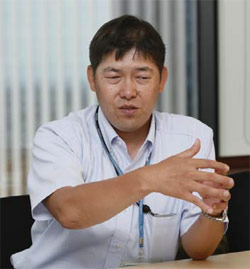 |
 |
| From left: Mr. Keitaro Konuma, Senior Manager, Composite Technologies Section, Structure Dept., Transport Infrastructure Division; Mr. Katsuyuki Ooya, Deputy Manager, Bridge Maintenance Section; Mr. Yohei Higashi, Deputy Manager, First Bridge Section. |
||
| Transportation Planning Dept.: Towards Development of Tsunami Evacuation Simulation Based on Accumulated Expertise in Transportation Systems |
Another division to pick up in this feature, Management Division deals with management in diverse fields, such as administration management, town planning, construction of recycling-oriented society, and formation of urban and social spaces. Transportation Planning Dept. in the Division works on planning and analysis pertaining to every kind of transportation including automobiles, pedestrians, bicycles, railroad, and aviation. They have been working on traffic simulation as dynamic analysis in evaluating such plans for many years.
Then after the Great East Japan Earthquake (2011), the evacuation issue has been attracting greater attention, and a need rose to create VR (virtual reality) based works from the analysis results of tsunami accumulated in another section in the company. Since Transportation Planning Dept. had also developed evacuation simulation by applying traffic simulation, UC-win/Road was adopted 2 years ago so that results of both simulations of evacuation and traffic simulation can be unified. Mr. Taichi Fudamoto in Transportation Strategy Section of the Dept. explains that tsunami evacuation simulation is under development based on 3D VR (three-dimensional virtual reality).
So far they assumed occurrence of tsunami damage with towns in a coastal region as its models. They created simulation to compare the state of evacuation that changes over time between the period before and after taking measures against tsunami. Some of the results are shown from the official channel of PCKK of YouTube "PacificConsultantsJP" (opened up on August 13 2013, http://www.youtube.com/user/PacificConsultantsJP). They also plan to show them open to the public through events such as ITS World Congress Tokyo 2013 in October. He says that in the future they are planning to develop more advanced simulation and VR-based videos linked with planning of a specific project.
Regarding their aim of utilizing VR, Mr. Teruo Yoshiike of the same Dept. says that evacuation simulation, which needs to be viewed and examined by a large number of people in public hearing and such, should be easy to understand; and that it is important for this purpose to develop VR-based videos that are easy to understand.
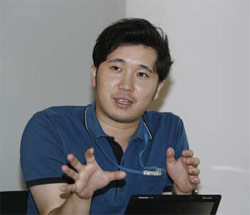 |
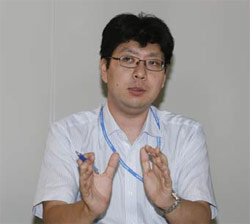 |
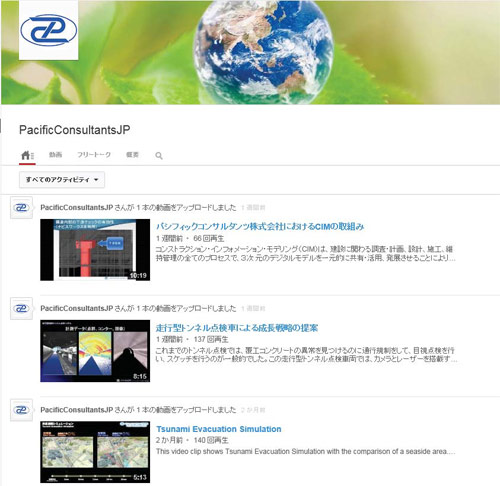 |
| From left: Mr. Taichi Fudamoto, Transportation Strategy Section, Transportation Planning Dept., Management Division; Mr. Teruo Yoshiike, Transportation Planning Dept., Management Division |
Top page of the PCKK official channel of YouTube "PacificConsultantsJP" | |
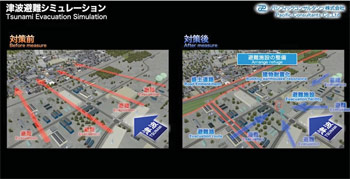 |
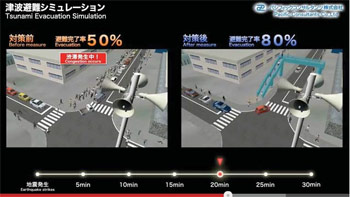 |
| Tsunami evacuation simulation (from "Tsunami evacuation simulation" released by the PCKK official channel of YouTube "PacificConsultantsJP" ) | |
| Future Response Based on Practical Use of CIM |
As mentioned above, PCKK started early to adopt various elemental technologies that lead to CIM, accumulating expertise about them. PCKK took the lead in participating the trial operation of CIM over the projects implemented by Ministry of Land, Infrastructure, Transport and Tourism (MLIT) in 2012 fiscal year (2 leading models out of 11). Through their official YouTube channel mentioned above, PCKK releases their main efforts in the trial operation including their original invention to make the members of a 3D model transparent to express it clearly when checking interference inside the structure, along with the advantages and problems of CIM obtained there.
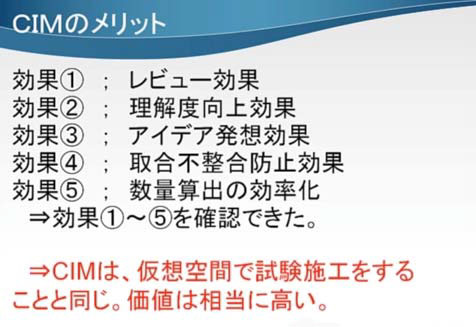 |
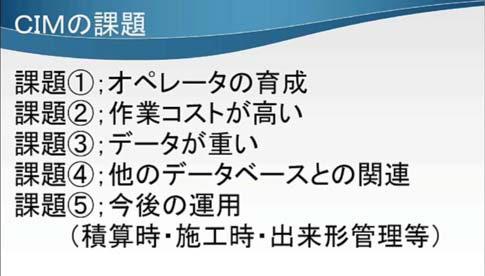 |
| Problems and advantages of CIM (from "Our approach to CIM in PACIFIC CONSULTANTS CO., LTD." released by the PCKK official channel of YouTube "PacificConsultantsJP" ) | |
As an extension of this, PCKK is supposed to basically apply CIM to road projects, while putting emphasis on securing environment that allows them to support CIM as to structures, in spite of some restrictions such as of software. At the same time, aiming to develop human resources who can support CIM, it is planned to hold an in-house seminar led by the head office with expert staff as instructors including Mr. Yasushi Itou, who took charge of CIM in the trial operation in the previous fiscal year.
Considering such progress, he insists that the future construction consultant should try to perform conceptual design, that is, integrated design.
As its backdrop, he mentions the importance of improving both aspects of holistic validity and numeric sensitivity in manufacturing. And that work process will involve an approach of integrating necessary and diversified elemental technologies with an excellent program.
"It is our business not to simply make a cross section but to have various ideas stored, such as appearance, workability, and low cost, and think about their combination."
 |
| At the office |
(Written by Takashi Ikeno)